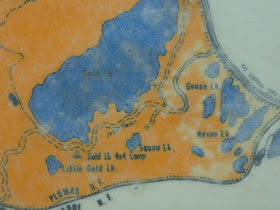Gold Lake's shoreline (elevation of 6,400 feet) in the Lakes Basin Recreation Area, Plumas County, California, is populated with monkey-flowers this year (middle of August), apparently unnoticed by most of the recreationally driven visitors.
Monkeyflowers of the genus Mimulus (lopseed family, Phrymaceae), embracing perhaps 150 species, are known for their “chaotic taxonomic history” [1]. Laird R. Blackwell's month-by-month guide of Tahoe wildflowers describes three yellow-flowered species: yellow-or-purple monkeyflower, Mimulus densus (March), common yellow monkeyflower, Mimulus guttatus (May) and primrose monkeyflower, Mimulus primuloides (July) [2]. These species are native to western North America and grow at elevations above 4,000 feet. All have been described to display reddish-brown spots in the corolla mouth.
Mimulus densus is associated with Nevada: Blackwell shows a beautiful Carson City flower pair [2]. Other sources refer to the Toiyabe Range in the Great Basin [3]. Further, what sometimes are treated as distinct species, may be treated as varieties as well [3]:
Holmgreen noted that “so close are the members of this complex [M. coccineus, M. densus, and M. mephiticus] that they are probably best treated as varieties under the oldest name M. mephiticus.” This whole group of plants need further study.
Elsewhere, the name M. densus has been labeled as unresolved [4]. Let's look at some details of the Gold Lake plants first, before further debating identification.
The flower and leaves shown in this post belong to plants seen on August 17 of this year at the shore of Gold Lake. The red splotches, typical for said Mimulus species, can clearly be seen in the top picture—most of them on the corolla's lowest of the five yellow sepals, where the flower opening is hairy. Each flower—having bilateral symmetry—arises above the basel leaves on a short, erect, leafless and purplish stalk. The green leaves vary in size and shape, and have long hairs. Older leaves are turning brownish purple (right-side picture above). The wet, partially shaded corners between low bushes and granite boulders seem to be the monkeyflower's favorite habitat, in which the low-growing plants often form small mats. There were plenty of plants around Gold Lake, but I couldn't find any at the shore of nearby Squaw Lake, which is situated at a somewhat higher elevation.
The heart shape of each of the yellow petals is another striking characteristic of the seen monkeyflowers. The petals of M. guttatus do not show such a pronounced heart shape and their flowers are born on a raceme. Therefore, and due to the ambiguous status of M. densus, I am leaning towards recognizing the Gold Lake flowers as M. primuloides: primrose monkeyflower, also called yellow creeping monkey-flower and monkey moss. But, how can one be sure within a large and complex genus with many look-alikes and a given history of renaming and sub-grouping?
Not only is the complexity of the Mimulus genus overwhelming, but its reorganization within the order Lamiales from the figwort family (Scrophulariaceae) to the lopseed family (Phrymaceae) complicates literature search and database querying.
Keywords: botany, biodiversity, classification, taxonomy, ambiguity, disambiguation.
References and more to explore
[1] Charles L. Argue: Pollen Morphology in the Genus Mimulus (Scrophulariaceae) and its Taxonomic Significance. Amer. J. Bot. 1980, 67 (1), 68-87 [www.jstor.org/discover/10.2307/2442538?uid=3739824&uid=2&uid=4&uid=3739256&sid=21102574525863].
[2] Laird R. Blackwell: Tahoe Wildflowers. Morris Book Publishing, LLC, 2007; pages 28, 54 and 93.
[3] Guy L. Nesom: Three Varieties raised to Specific Rank in Diplacus (Phrymaceae). Phytoneuron 2012, 47, 1-6 [www.phytoneuron.net/PhytoN-Diplacuscompactus.pdf].
[4] The Plant List. A working list of all plant species: Mimulus densus A. L. Grant is an unresolved name [www.theplantlist.org/tpl/record/kew-2506073].



























